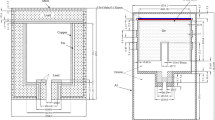Abstract
Introduction
The dead layer thickness provided by the manufacturer increases with the aging of the HPGe detector; the increase of dead layer thickness leads to the decrease in the detector’s efficiency, not only due to gamma rays attenuation in the dead layer but also due to the reduction of the active volume of the detector.
Purpose
In this work, the dead layer influence on HPGe detector efficiency was studied by Monte Carlo simulation.
Materials and methods
The detector model was developed using Monte Carlo N Particle (MCNP5) code for adjustment of the dead layer thickness; the adjustment was performed according to a specific irradiation configuration by collimation approach using three reference point sources: 241Am (59.5 keV), 137Cs (661.6 keV) and 60Co (1173.2 keV; 1332.5 keV).
Result
The calculated efficiencies were compared to the measured intrinsic efficiency ones for these point sources; a good agreement between Monte Carlo and measurements results was found after the experimental validation.
Conclusion
The results confirm the variation in the dead layer thickness according to aging of the detector; the average change of dead layer is in order of 1.30 ± 0.05 mm after 9 years.





Similar content being viewed by others
References
A. Azbouche, M. Belgaid, H. Mazrou, Monte Carlo calculations of the HPGe detector efficiency for radioactivity measurement of large volume environmental samples. J. Environ. Radioact. V146, 119–124 (2015)
E. Chham, F.P. García, T. El Bardouni, M.A. Ferro-García, M. Azahra, K. Benaalilou, M. Krikiz, H. Elyaakoubi, J. El Bakkali, M. Kaddour, Monte Carlo analysis of the influence of germanium dead layer thickness on the HPGe gamma detector experimental efficiency measured by use of extended sources. Appl. Radiat. Isot. 95, 30–35 (2015)
F. Bochud, C.J. Bailat, T. Buchillier, F. Byrde, E. Schmid, J.P. Laedermann, Simple Monte-Carlo method to calibrate well-type HPGe detectors. Nucl Instrum Methods Phys Res A 569, 790–795 (2006)
J. Boson, G. Agren, L. Johansson, A detailed investigation of HPGe detector response for improved Monte Carlo efficiency calculations. Nucl Instrum Methods Phys Res A 587, 304–314 (2008)
E. Andreotti, M. Hult, G. Marissens, G. Lutter, A. Garfagnini, S. Hemmer, K. Von Sturm, Determination of dead-layer variation in HPGe detectors. Appl. Radiat. Isot. 87, 331–335 (2014)
D. Budjáš, M. Heisel, W. Maneschg, H. Simgen, Optimisation of the MC-model of a p-type Ge-spectrometer for the purpose of efficiency determination. Appl. Radiat. Isot. V67(I5), 706–710 (2009)
E. Chham, F. Piñero García, T. El Bardouni, M. Angeles Ferro-García, M. Azahra, Monte Carlo analysis of the influence of germanium dead layer thickness on HPGe gamma detector experimental efficiency measured by use of extended sources. Appl. Radiat. Isot. 95, 30–35 (2015)
T. Ersmark et al., Status of the DESIRE Project: GEANT4 physics validation studies and first results from Columbus/ISS radiation simulations. IEEE Trans. Nucl. Sci. 51(4), 1378–1384 (2004)
F. Salvat, J.M. Fernández-Varea, J. Sempau, PENELOPE-2011: A Code System for Monte Carlo Simulation of Electron and Photon Transport OECD NEA Data Bank/NSC DOC(2011)/5 (OECD Nuclear Energy Agency, Issy-les-Moulineaux, 2011)
X-5 Monte Carlo Team, in Overview and Theory. MCNP a General Monte Carlo N Particle Transport Code, Version 5 (Los Alamos National Laboratory LA-UR 03-1987, 2003).
J. Ródenas, A. Pascual, I. Zarza, V. Serradell, J. Ortiz, L. Ballesteros, Analysis of the influence of germanium dead layer on detector calibration simulation for environmental radioactive samples using the Monte Carlo method. Nucl. Instrum. Methods Phys. Res. Sect. A V496(I2–3), 390–399 (2003)
A. Elanique, O. Marzocchi, D. Leone, L. Hegenbart, B. Breustedt, L. Oufni, Dead layer thickness characterization of an HPGe detector by measurements and Monte Carlo simulations. Appl. Radiat. Isot. 70, 538–542 (2012)
S. Kamboj, B. Kahna, Use of Monte Carlo simulation to examine gamma-ray interactions in germanium detectors. Radiat. Meas. 37, 1–8 (2003)
M.C. Lépy, T. Altzitzoglou, D. Arnold, F. Bronson, R. Capot Noye, M. Décombaz, F. De Corte, R. Edelmaier, E. Herrera Peraza, S. Klemola, M. Korun, M. Kralik, H. Neder, J. Plagnard, S. Pommè, J. De Sanoit, O. Sima, F. Ugletveit, L. Van Velzen, T. Vidma, Inter comparison of efficiency transfer software for gamma-ray spectrometry. Appl. Radiat. Isot. 55, 493–503 (2001)
M.J. Vargas, A.F. Timón, N.C. Dı́az, D.P. Sánchez, Monte Carlo simulation of the self-absorption corrections for natural samples in gamma-ray spectrometry. Appl. Radiat. Isot. V5(I6), 893–898 (2002)
J.C. Hardy, V.E. Iacob, M. Sanchez-Vega, R.T. Effinger, P. Lipnik, V.E. Mayes, D.K. Willis, R.G. Helmer, precise efficiency calibration of an HPGe detector: source measurements and Monte Carlo calculations with sub-percent precision. Appl. Radiat. Isot. 56, 65–69 (2002)
F. Courtine, T. Pilleyre, S. Sanzelle, D. Miallier, Ge well detector calibration by means of a trial and error procedure using the dead layers as a unique parameter in a Monte Carlo simulation. Nucl. Instrum. Methods Phys. Res. A 596, 229–234 (2008)
Canberra Industries, in Solid-State Photon Detector, Operators Manual, GMX Series, HPGe (High-Purity Germanium)
Canberra Industries, in Detector Lead Shields, Model 747 and 747E, C40114 – 04/13. www.canberra.com
G.F. Knoll, Radiation Detection and Measurement, 3rd edn. (Wiley, New York, 2000)
P. Dryak, P. Kovar, Experimental and MC determination of HPGe detector efficiency in the 40–2754 keV energy range for measuring point source geometry with the source-to-detector distance of 25 cm. Appl. Radiat. Isot. 64, 1346–1349 (2006)
T. Nakamura, T. Suzuki, Monte Carlo calculation of peak efficiencies of Ge(Li) and pure Ge detectors to voluminal sources and comparison with environmental radioactivity measurement. Nucl. Instrum. Methods Phys. Res. V205(I1–2), 211–218 (1983)
N.Q. Huy, The influence of dead layer thickness increase on efficiency decrease for a coaxial HPGe p-type detector. Nucl. Instrum. Methods Phys. Res. A 621, 390–394 (2010)
Author information
Authors and Affiliations
Corresponding author
Rights and permissions
About this article
Cite this article
Azbouche, A., Belamri, M. & Tchakoua, T. Study of the germanium dead layer influence on HP(Ge) detector efficiency by Monte Carlo simulation. Radiat Detect Technol Methods 2, 45 (2018). https://doi.org/10.1007/s41605-018-0074-y
Received:
Revised:
Accepted:
Published:
DOI: https://doi.org/10.1007/s41605-018-0074-y




